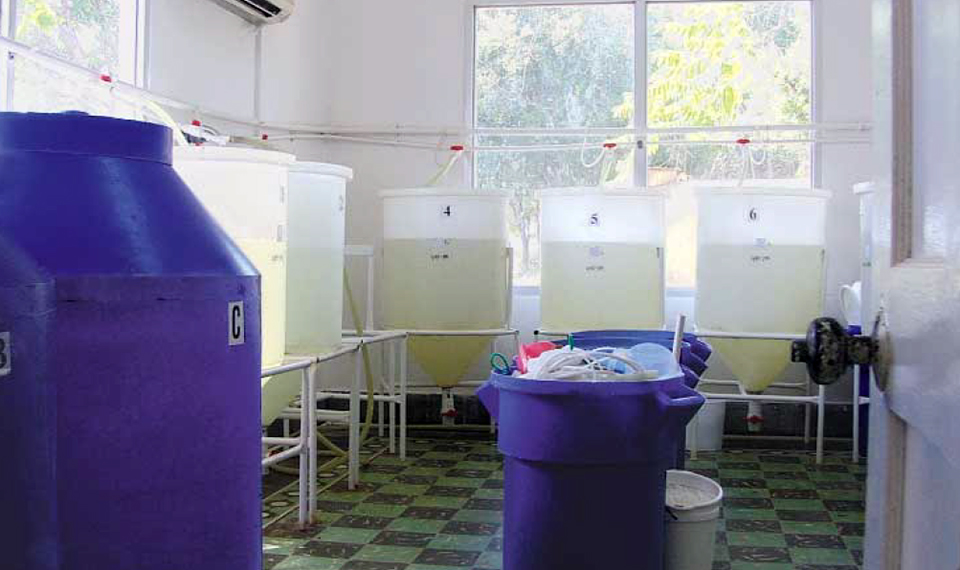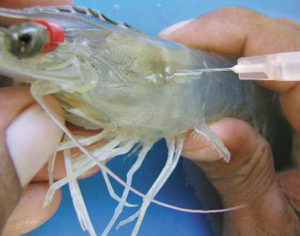Necrotizing hepatopancreatitis has year-round impacts

Necrotizing hepatopancreatitis (NHP) in Pacific white shrimp (Litopenaeus vannamei) was first recognized in 1985 in Texas, USA. Based on histopathology and ultrastructure, the etiology of this disease was related to an intracellular bacterium. Later, the sequence analysis of the cloned 16 rDNA of this pathogen indicated that the NHP bacterium is a member of the alpha proteobacteria subclass.
Pathogen detection was made possible by using a nonradioactive probe and polymerase chain reaction (PCR). Successful transmission of NHP was accomplished through injection with a suspension of microorganisms isolated from infected shrimp, while infection by immersion failed.
PCR detection, rates of infection
The authors developed an NHP study in Panama, with complementary analysis in Ecuador and Peru during 2003. A nested PCR assay was first developed to increase the sensitivity of the current PCR assay. As a consequence, the infection rates were significantly higher in all samplings.
In preadult broodstock, the NHP mean prevalence was about 28 percent in Panama. A large-scale epidemiological survey in postlarvae led to detection of NHP bacteria in 22.5 percent of the samples in Panama and 20.4 percent of those in Ecuador.
In Panama, Ecuador and Peru, the prevalence of NHP in shrimp juveniles can sometimes reach 100 percent in extensive and intensive systems. Epidemiological surveys showed a significant difference for NHP prevalence between apparently healthy juveniles and moribund juveniles collected from the same pond. Preliminary data related to similar postlarvae cultivated in parallel in ponds with and without greenhouses indicated an enhanced effect of high temperature on the development of NHP bacteria.
Impacts on shrimp productivity
The authors evaluated the impacts of NHP on productivity through the comparison of survival and weekly growth rates for several shrimp lines (Table 1). Each line was cultivated individually at a density of 83 animals per square meter for 90 days in floating cages placed in the same pond at a farm in Panama.
Leclercq, Low NHP-infected lines had survival, Table 1
| Line Type | NHP Prevalence | Line Number | Survival | Weekly Growth Rate | Productivity Decrease |
|---|
Line Type | NHP Prevalence | Line Number | Survival | Weekly Growth Rate | Productivity Decrease |
|---|---|---|---|---|---|
| Noninfected | 0% | 25 | 30% | 0.47 g | 0% |
| Low-infected | 10-20% | 8 | 29% | 0.44 g | 10% |
| Highly infected | 50-60% | 8 | 14% | 0.38 g | 60% |
The low NHP-infected lines (prevalence 10 to 20 percent) had survival and weekly growth rates similar to noninfected animals. Compared to noninfected shrimp, productivity was reduced by 60 percent and 10 percent, respectively, for the lines with high (50 to 60 percent) and low (10 to 20 percent) NHP infection rates.
Horizontal, vertical transmission

Horizontal transmission was demonstrated using healthy larvae produced from females diagnosed as NHP-free through postmortem nested PCR on hepatopancreas homogenate. Infections of healthy larvae were accomplished by feeding highly NHP-infected hepatopancreas tissue.
The detection of NHP bacteria occurred as soon as 10 days after infection in sacrificed larvae. The infection rate reached 90 percent at 70 days post-infection. Control larvae fed NHP-negative hepatopancreas were all diagnosed as NHP-negative. These results showed that NHP-bacteria are highly transmissible through cannibalism.
Several related species collected in shrimp ponds (crabs, copepods, Callianasa sp.) were also infected with NHP bacteria at 60 to 100 percent infection rates. Such crustaceans could represent reservoir species for NHP bacteria, especially the Lepidophthalmus sp. callianassids that can move deeply into pond sediments and persist over long periods of drying.
Vertical transmission is highly suspected, since NHP bacteria were frequently detected in young larvae. Moreover, NHP bacteria were detected in eggs and nauplii from females that were diagnosed as NHP-positive through nested PCR. Tests were performed before spawning on ovary biopsy and subsequently on hepatopancreas homogenate after sacrificing the animals.
NHP prevention
In the cases of white spot syndrome virus and infectious hypodermal and hematopoietic necrosis virus, prevention has been successfully achieved on the basis of individual analyses of females through nested PCR analysis of hemolymph samples. Yet NHP bacteria are rarely (2 percent) detected in the hemolymph of NHP-infected shrimp.
Biopsy protocols without deleterious effects for the shrimp tested have been developed for hepatopancreas, ovaries and testicles. However, NHP detection through nested PCR performed on small biopsied samples proved about 50 percent less reliable than detection using homogenates of whole organs from sacrificed animals.
Consequently, prevention of NHP can not be fully achieved by individual analysis of shrimp and the exclusive use of NHP-negative females. Prevention of NHP depends on the selection of adult groups with the lowest NHP prevalence. In Panama, it has been possible to select several families with a mean NHP prevalence of 3 percent Some NHP-free families are currently used as broodstock.
Possible treatments
An alternative strategy is the establishment of NHP-free batches from broodstock treated with antibiotics. Since oxytetracycline is authorized for use in aquaculture, the authors evaluated its use for NHP treatment of experimentally infected larvae. A bacteriostatic effect was observed for 50 to 5,000 ppm concentrations of oxytetracycline introduced during 10 days as a food supplement.
Experiments in progress with adult treatments will determine if the transitory bacteriostatic effect of oxytetracycline is sufficient to produce NHP-free larvae. Such adult treatments have been successfully applied in several insect and crustacean species to eliminate intracellular Wolbachia bacteria.
Conclusion
NHP-causing bacteria are associated with L. vannamei in several countries at relatively high prevalence as a consequence of its transmission mechanisms. Because of their year-round deleterious impacts on shrimp growth and survival in semi-intensive and intensive cultures, the microorganisms are serious pathogens.
NHP-causing bacteria have similarities to the Wolbachia bacteria that are known to induce cytoplasmic incompatibility and sterility in their hosts. Such biological processes should be investigated further, since they can dramatically hamper shrimp domestication and breeding programs.
(Editor’s Note: This article was originally published in the August 2004 print edition of the Global Aquaculture Advocate.)
Now that you've finished reading the article ...
… we hope you’ll consider supporting our mission to document the evolution of the global aquaculture industry and share our vast network of contributors’ expansive knowledge every week.
By becoming a Global Seafood Alliance member, you’re ensuring that all of the pre-competitive work we do through member benefits, resources and events can continue. Individual membership costs just $50 a year. GSA individual and corporate members receive complimentary access to a series of GOAL virtual events beginning in April. Join now.
Not a GSA member? Join us.
Authors
-
G. Leclercq
Concepto Azul
P.O. Box 09-02-142A
Cdla. Vernaza Norte
Mz 10, Villa 34
Guayaquil, Ecuador
concepto@gye.satnet.net -
D. Zambrano
Concepto Azul
P.O. Box 09-02-142A
Cdla. Vernaza Norte
Mz 10, Villa 34
Guayaquil, Ecuador
concepto@gye.satnet.net -
A. Escobar
Concepto Azul
P.O. Box 09-02-142A
Cdla. Vernaza Norte
Mz 10, Villa 34
Guayaquil, Ecuador
concepto@gye.satnet.net -
V. Cedeño
Concepto Azul
P.O. Box 09-02-142A
Cdla. Vernaza Norte
Mz 10, Villa 34
Guayaquil, Ecuador
concepto@gye.satnet.net -
E. Motte
Concepto Azul
P.O. Box 09-02-142A
Cdla. Vernaza Norte
Mz 10, Villa 34
Guayaquil, Ecuador
concepto@gye.satnet.net -
V. Boulo
Concepto Azul
P.O. Box 09-02-142A
Cdla. Vernaza Norte
Mz 10, Villa 34
Guayaquil, Ecuador
concepto@gye.satnet.net -
E. Mialhe
Concepto Azul
P.O. Box 09-02-142A
Cdla. Vernaza Norte
Mz 10, Villa 34
Guayaquil, Ecuador
concepto@gye.satnet.net -
R. Chamorro
Camaronera de Coclé S.A.
Aguadulce, Coclé, Panama -
G. Martinez
Camaronera de Coclé S.A.
Aguadulce, Coclé, Panama -
J. Visuetti
Camaronera de Coclé S.A.
Aguadulce, Coclé, Panama -
M. Arevalo
Camaronera de Coclé S.A.
Aguadulce, Coclé, Panama -
R. Camargo
Camaronera de Coclé S.A.
Aguadulce, Coclé, Panama -
E. Correa
Camaronera de Coclé S.A.
Aguadulce, Coclé, Panama -
E. Moreno
Camaronera de Coclé S.A.
Aguadulce, Coclé, Panama
Tagged With
Related Posts

Health & Welfare
Colombian shrimp research associates TSV, NHP selection, resistance
In an NHP (necrotizing hepatopancreatitis) challenge test, shrimp from a Colombian breeding program had higher resistance and 30 percent greater survival than a control line of Taura syndrome virus-free shrimp.

Health & Welfare
Development of new and real-time PCR for detection and quantification of NHPB
Authors describe conventional PCR and real-time PCR assays based on the NHPB flgE gene as alternative methods for the detection and quantification of NHPB in shrimp and shrimp-associated samples, including artemia. This newly described method will be an additional diagnostic tool for confirmation of this pathogen.

Health & Welfare
Rapid test detects NHP in penaeid shrimp
A rapid lateral-flow immunoassay using monoclonal antibody combinations can identify necrotizing hepatopancreatitis (NHP) infection in less than 15 minutes.

Health & Welfare
Wet mount technique excellent for health monitoring, not NHP diagnosis in shrimp
Necrotizing hepatopancreatitis is a disease of shrimp that causes slow growth, low survival and poor feed conversion. Wet mount analysis is commonly used to diagnose NHP in ponds in Brazil.


